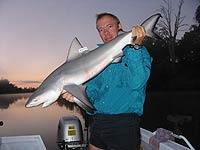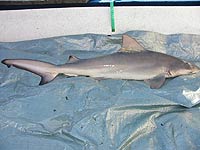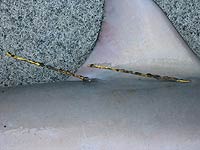Techniques for release
Always have good gloves and a wet towel handy and if possible, a soft, shady surface on which to place the shark. When a shark is brought to the boat, either net it, or swing it on board and quickly lay it horizontally, on a soft carpet or piece of sponge. Do not place fish on hot surfaces since their skin may burn easily. Hold the shark firmly behind the head and around the tail wrist using gloves and/or a wet towel, and then try to remove the hook.
If the hook cannot be removed easily the line should be cut as close to the mouth as possible. Usually hooks will eventually fall out or pass through the stomach whereas trying to remove a deeply lodged hook could damage internal organs or blood vessels.
The internal organs of many species of shark are loosely held in place by connective tissue. In the water, these organs are supported, but if the shark is lifted by the tail, the tissue may tear. There is also the danger of damaging tendons which hold the vertebrae in place. These problems are less likely to damage small sharks, but the best rule is to always try and lift sharks in a horizontal position. This can be done using a large net or by holding the shark by the tail wrist with one hand, and placing the other hand under the belly.
Sharks twist and turn when captured, so you need to be careful and protect the angler and the shark or ray from injury (quite a few nasty injuries have been caused by a thrashing shark in the bottom of a small boat). Often, if a shark is turned over onto its back, or held upside down, it will become quite calm and easy to handle, probably because it becomes confused in this position. As well as laying sharks on their backs, placing a wet towel over their eyes will also often help to calm them.
In the case of sting rays it is best to simply cut the line as close to the mouth as possible while the ray is still in the water. As most people know, many species of sting rays have very dangerous serrated barbs on their tails that can cause serious and painful injuries. (If you are unlucky enough to be stung, apply very hot water to the area of the wound. Heat stops the venom from working, although care should be taken not to burn the patient.) While it is true that not all rays are equipped with barbs in their tails, the best rule is to never handle any ray which possesses a whip-like tail. |

River whalers also known as bull sharks
(Carcharhinus leucas) (© Neil Schultz)

Tagged bull shark (Carcharhinus leucas)
(© Neil Schultz)

Tagged bull shark (Carcharhinus leucas)
(© Neil Schultz) |
